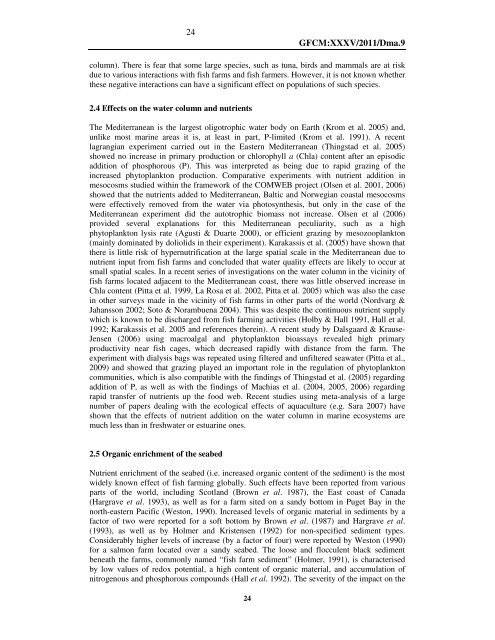Site selection and carrying capacity in Mediterranean ... - FAO Sipam
Site selection and carrying capacity in Mediterranean ... - FAO Sipam
Site selection and carrying capacity in Mediterranean ... - FAO Sipam
You also want an ePaper? Increase the reach of your titles
YUMPU automatically turns print PDFs into web optimized ePapers that Google loves.
24<br />
24<br />
GFCM:XXXV/2011/Dma.9<br />
column). There is fear that some large species, such as tuna, birds <strong>and</strong> mammals are at risk<br />
due to various <strong>in</strong>teractions with fish farms <strong>and</strong> fish farmers. However, it is not known whether<br />
these negative <strong>in</strong>teractions can have a significant effect on populations of such species.<br />
2.4 Effects on the water column <strong>and</strong> nutrients<br />
The <strong>Mediterranean</strong> is the largest oligotrophic water body on Earth (Krom et al. 2005) <strong>and</strong>,<br />
unlike most mar<strong>in</strong>e areas it is, at least <strong>in</strong> part, P-limited (Krom et al. 1991). A recent<br />
lagrangian experiment carried out <strong>in</strong> the Eastern <strong>Mediterranean</strong> (Th<strong>in</strong>gstad et al. 2005)<br />
showed no <strong>in</strong>crease <strong>in</strong> primary production or chlorophyll a (Chla) content after an episodic<br />
addition of phosphorous (P). This was <strong>in</strong>terpreted as be<strong>in</strong>g due to rapid graz<strong>in</strong>g of the<br />
<strong>in</strong>creased phytoplankton production. Comparative experiments with nutrient addition <strong>in</strong><br />
mesocosms studied with<strong>in</strong> the framework of the COMWEB project (Olsen et al. 2001, 2006)<br />
showed that the nutrients added to <strong>Mediterranean</strong>, Baltic <strong>and</strong> Norwegian coastal mesocosms<br />
were effectively removed from the water via photosynthesis, but only <strong>in</strong> the case of the<br />
<strong>Mediterranean</strong> experiment did the autotrophic biomass not <strong>in</strong>crease. Olsen et al (2006)<br />
provided several explanations for this <strong>Mediterranean</strong> peculiarity, such as a high<br />
phytoplankton lysis rate (Agusti & Duarte 2000), or efficient graz<strong>in</strong>g by mesozooplankton<br />
(ma<strong>in</strong>ly dom<strong>in</strong>ated by doliolids <strong>in</strong> their experiment). Karakassis et al. (2005) have shown that<br />
there is little risk of hypernutrification at the large spatial scale <strong>in</strong> the <strong>Mediterranean</strong> due to<br />
nutrient <strong>in</strong>put from fish farms <strong>and</strong> concluded that water quality effects are likely to occur at<br />
small spatial scales. In a recent series of <strong>in</strong>vestigations on the water column <strong>in</strong> the vic<strong>in</strong>ity of<br />
fish farms located adjacent to the <strong>Mediterranean</strong> coast, there was little observed <strong>in</strong>crease <strong>in</strong><br />
Chla content (Pitta et al. 1999, La Rosa et al. 2002, Pitta et al. 2005) which was also the case<br />
<strong>in</strong> other surveys made <strong>in</strong> the vic<strong>in</strong>ity of fish farms <strong>in</strong> other parts of the world (Nordvarg &<br />
Jahansson 2002; Soto & Norambuena 2004). This was despite the cont<strong>in</strong>uous nutrient supply<br />
which is known to be discharged from fish farm<strong>in</strong>g activities (Holby & Hall 1991, Hall et al.<br />
1992; Karakassis et al. 2005 <strong>and</strong> references there<strong>in</strong>). A recent study by Dalsgaard & Krause-<br />
Jensen (2006) us<strong>in</strong>g macroalgal <strong>and</strong> phytoplankton bioassays revealed high primary<br />
productivity near fish cages, which decreased rapidly with distance from the farm. The<br />
experiment with dialysis bags was repeated us<strong>in</strong>g filtered <strong>and</strong> unfiltered seawater (Pitta et al.,<br />
2009) <strong>and</strong> showed that graz<strong>in</strong>g played an important role <strong>in</strong> the regulation of phytoplankton<br />
communities, which is also compatible with the f<strong>in</strong>d<strong>in</strong>gs of Th<strong>in</strong>gstad et al. (2005) regard<strong>in</strong>g<br />
addition of P, as well as with the f<strong>in</strong>d<strong>in</strong>gs of Machias et al. (2004, 2005, 2006) regard<strong>in</strong>g<br />
rapid transfer of nutrients up the food web. Recent studies us<strong>in</strong>g meta-analysis of a large<br />
number of papers deal<strong>in</strong>g with the ecological effects of aquaculture (e.g. Sara 2007) have<br />
shown that the effects of nutrient addition on the water column <strong>in</strong> mar<strong>in</strong>e ecosystems are<br />
much less than <strong>in</strong> freshwater or estuar<strong>in</strong>e ones.<br />
2.5 Organic enrichment of the seabed<br />
Nutrient enrichment of the seabed (i.e. <strong>in</strong>creased organic content of the sediment) is the most<br />
widely known effect of fish farm<strong>in</strong>g globally. Such effects have been reported from various<br />
parts of the world, <strong>in</strong>clud<strong>in</strong>g Scotl<strong>and</strong> (Brown et al. 1987), the East coast of Canada<br />
(Hargrave et al. 1993), as well as for a farm sited on a s<strong>and</strong>y bottom <strong>in</strong> Puget Bay <strong>in</strong> the<br />
north-eastern Pacific (Weston, 1990). Increased levels of organic material <strong>in</strong> sediments by a<br />
factor of two were reported for a soft bottom by Brown et al. (1987) <strong>and</strong> Hargrave et al.<br />
(1993), as well as by Holmer <strong>and</strong> Kristensen (1992) for non-specified sediment types.<br />
Considerably higher levels of <strong>in</strong>crease (by a factor of four) were reported by Weston (1990)<br />
for a salmon farm located over a s<strong>and</strong>y seabed. The loose <strong>and</strong> flocculent black sediment<br />
beneath the farms, commonly named “fish farm sediment” (Holmer, 1991), is characterised<br />
by low values of redox potential, a high content of organic material, <strong>and</strong> accumulation of<br />
nitrogenous <strong>and</strong> phosphorous compounds (Hall et al. 1992). The severity of the impact on the
















